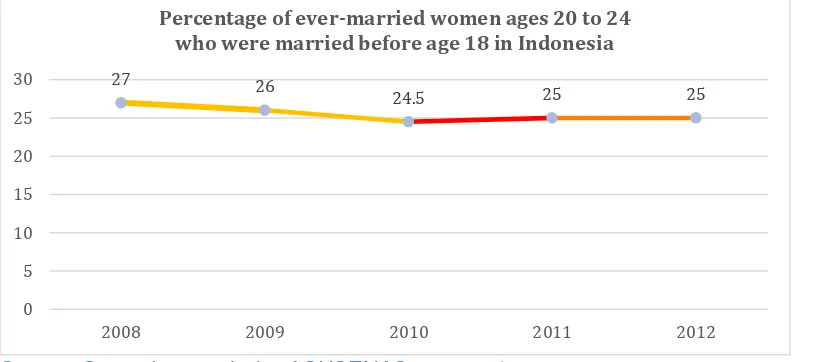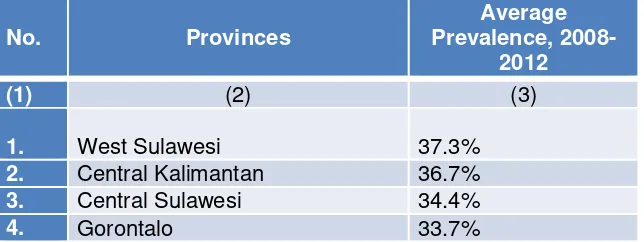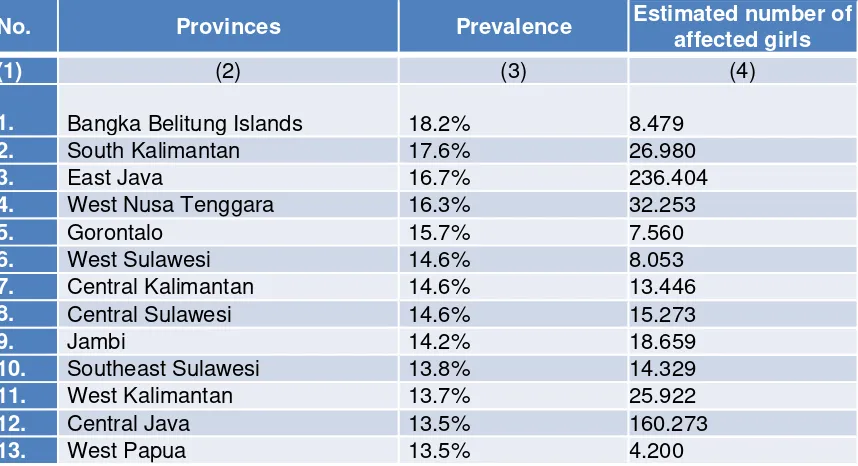POLICY BRIEF
Child Marriage in Indonesia: Past progress at a standstill
Background
Child marriage has garnered significant global attention in the last decade in response to growing evidence on the scale and scope of the problem. An estimated 14.2 million girls worldwide marry before age 18 each year.1 Over 700 million women alive today were once child brides, and one in three of these girls married before age 15.2
Child marriage is a fundamental violation of girls’ human rights. It
limits girls’ education, health, future income, safety, agency and abilities. It also restricts their status and roles in both the home and in society. The practice is largely driven by poverty and social norms that are rooted in the lower status of women and girls.
Girls who marry early face devastating risks to their health and well-being. Pregnancy-related deaths are the leading cause of death among girls ages 15-19 worldwide. Married girls have poorer nutrition, and child brides have higher risk for domestic violence and are more accepting of violence perpetrated against them. Married girls also have poorer educational and economic prospects, which reinforce their lower status and poverty. These effects are passed onto their children, continue into future generations, and serve as a drain on social and economic growth.
Child Marriage in Indonesia
Indonesia has frequently been lauded for its two-fold decline in child marriage prevalence in the last three decades, with a current rate of 17 percent according to global estimates.3 Yet, this rate still represents nearly more than one in six girls marrying before reaching adulthood.
Under the 1974 Marriage Law that sets the legal parameters for marriage in Indonesia, parental consent is required for all marriages under age 21. With parental consent, females can legally marry at age 16 and males at 19. Parents can petition marriage officers or district-level religious courts for an exemption to marry their daughter even earlier, with no minimum age limit.4 More than 90 percent of exemption requests are accepted, and the number of applications is rising.5
The Marriage Law not only fails to meet the age 18 threshold for marriage recommended by International Human Rights Treaty Bodies, it contradicts Indonesia’s own 2002 Law on Child Protection, which prohibits marriage under age 18 under any circumstances. It also sets the minimum marriage age lower for girls than boys, even though girls are more vulnerable to the harmful consequences of child marriage.6 The Marriage Law does not require proof of age at marriage, making it all the more difficult to protect girls.
Findings from New Research in Indonesia
2
1. Progress in reducing child marriage in Indonesia has plateaued and child marriage prevalence remains persistently high: Even with declines over the last three decades, the child marriage rate in Indonesia today is still high, with over one in six girls, or 340,000 annually, currently marrying before reaching adulthood.1 Further, the rate has plateaued in recent years. Figure 1 shows that while declines occurred from 2008 to 2010, the child marriage rate increased in 2011 and then leveled off in 2012.Marriage among girls below age 15 declined by one-third during the same time period (from 3.0% to 2.1%) with rural areas accounting for most of this decrease. This decline occurred in all provinces except for Central, South, East and West Kalimantan provinces. While a decline is encouraging, 50,000 girls still marry before age 15 each year in Indonesia.
Figure 1: Percentage of ever-married women ages 20 to 24 who were married before age 18 in Indonesia, 2008 to 2012
Source: Secondary analysis of SUSENAS 2008-2012
2. Child marriage is highest amongst girls ages 16 and 17: While marriage of girls under age 15 has declined, marriage among girls ages 16 and 17 has risen steadily, indicating that protection for girls falls away around age 16. Among married adolescent girls ages 15-19, marriage before age 16 declined from 7.2 percent to 5.5 percent between 2008 and 2012. During the same period, marriage among all girls under 18 rose slightly and then stabilized. These differing trends indicate fewer girls are marrying before 16, but once they reach this age an increasing number marry within the next two years, before they reach 18. This indicates that marriage of girls ages 16 and 17 is still viewed as acceptable in much of Indonesian society.
3. Child marriage and education are interlinked: The analysis found a strong correlation between child marriage and lower levels of education, as well as later marital age and higher levels of education. Among adolescent girls ages
15-1This figure is calculated by multiplying Indonesia’s child marriage rate (17%) by the total number of women ages 20-24 (10,003,920 women according to 2010 census data), and dividing by 5 to capture a yearly average for the 20-24 age range.
27
Percentage of ever-married women ages 20 to 24 who were married before age 18 in Indonesia
Table 1: Females ages 15-19 by marital status and educational attainment
3
child marriage likely ends a girl’s education.Many married adolescent girls do not complete education beyond the primary school level. It is more likely for married girls to never attend or not to complete primary school compared to unmarried girls (7% and 2% respectively). Furthermore, nearly one-third more married girls report primary school as their highest level of educational attainment compared to unmarried girls (36% and 24% respectively).
Secondary school provides the best protection for delaying marriage until girls reach adulthood: 40.8 percent of girls who complete primary school marry before age 18, compared with 26.6 percent of girls who complete junior secondary school and 5.1 percent of girls who complete senior secondary school.
4. While poverty makes girls much more vulnerable to child marriage, social and cultural acceptance permeates all economic levels: Analysis showed that child marriage is strongly related to rural residence, poorer housing conditions, and lower levels of wealth, all categories associated with poverty. Child marriage is more than 1.5 times higher in rural compared to urban areas (29.6% and 19.1% respectively in 2012). Child marriage rates also increased as housing conditions deteriorated from adequate (21.7%) to inadequate (36.4%). In addition, girls from the poorest 20 percent of households were almost twice as likely to be married before age 18 compared to girls from the richest 20 percent of households.
However, the data also showed that social norms accepting of the practice are influential among all economic levels in Indonesian society. Nearly one in six girls marry before age 18 among the richest households in Indonesia, indicating that financial security provides only limited protection.
5. Extremely high rates of child and adolescent marriage are found in geographical pockets throughout Indonesia: Analysis of geographical data from the 2010 census found rates varied widely across the country and by geographical level. Some of the highest-prevalence sub-districts were located in low prevalence districts and provinces, while some low-prevalence districts and provinces had large populations resulting in extremely large numbers of girls marrying before 18.
Table 2: Ranked list of provinces by female child marriage prevalence
This table shows the average prevalence of ever married women aged 20-24 who have been married before age 18 (from 2008-2012 SUSENAS). Looking at the average prevalence from 2008 to 2012, West Sulawesi has the highest prevalence at 37.3 per cent, followed by both Central Kalimantan and Central Sulawesi (36.7 per cent and 34.4. per cent respectively). DKI Jakarta has the lowest average prevalence at 13 per cent.
No. Provinces
Figure 2: Percentage of ever-married women 20-24 years married before age 18 by wealth quintile
4
Table 3: Ranked list of provinces by female adolescent marriage (15-19 years old) prevalence
No. Provinces Prevalence Estimated number of
affected girls
(1) (2) (3) (4)
1. Bangka Belitung Islands 18.2% 8.479
2. South Kalimantan 17.6% 26.980
3. East Java 16.7% 236.404
4. West Nusa Tenggara 16.3% 32.253
5. Gorontalo 15.7% 7.560
6. West Sulawesi 14.6% 8.053
7. Central Kalimantan 14.6% 13.446
8. Central Sulawesi 14.6% 15.273
9. Jambi 14.2% 18.659
10. Southeast Sulawesi 13.8% 14.329
11. West Kalimantan 13.7% 25.922
12. Central Java 13.5% 160.273
5
affected by child marriage in respective provinces. Nationally, female adolescent marriage prevalence (for 15-19 years old) is 11.5 per cent. Prevalence rate in each province is between 3.1 to 18.3 per cent. Female adolescent marriage prevalence is lowest in DKI Jakarta, Aceh and Riau Islands (3.3%. 3/3% and 3.1% respectively). Highest prevalence is found in Bangka Belitung Islands, South Kalimantan and East Java. Looking at the absolute numbers, East and West Java has the highest numbers of female adolescents who were married (236.404 and 220.501 respectively). Central Java also has high absolute numbers of female adolescent marriage, which is affecting 160.273 girls. While Bangka Belitung is one of the highest prevalent female adolescent marriage areas, the absolute numbers of girls that are affected is among the lowest in the country. A dual approach of working on both percentage and scale is required by decision makers if Indonesia is to make progress in achieving the new sustainable development goal (SDG) target of eliminating child marriage by 2030.Districts and Sub-districts: 106 districts had female adolescent marriage rates of 20 percent or higher.2 The highest prevalence of female adolescent marriage can be found in Central Java, East Java and South Kalimantan. Provincial data from the census can mask the districts where such prevalence is highest. For example, while Central Java’s prevalence is 13.2 per cent, Wonosobo prevalence is 63%. In East Java, the provincial prevalence within this age range is 15 per cent, while its districts range from 5 to 35 per cent and sub-districts range from 2 to 64 per cent. The districts with the highest prevalence (Bondowoso at 35%, Probolinggo at 35%, Situbondo at 34% and Sumenep at 32%) have sub-districts with even higher values, such as Sumbermalang in Probolinggo with 64 per cent.
Of the 5,031 sub-districts in Indonesia, 1,085 sub-districts had above 25 per cent prevalence. In other words, 22 per cent of sub-districts feature prevalence of at least twice as high as the national average. Analysis of sub-districts showed that although most provinces include sub-districts with female adolescent marriage prevalence higher than 25 per cent. East Java, Central Java and South Kalimantan had the greatest number of high prevalence sub-districts.
6
Opportunities for ActionWhile there has been great progress on child marriage in Indonesia – particularly among girls 15 and younger – there is still much to be done. The report offered five recommendations to help end child marriage in Indonesia:
1. Increase coverage of education services and other support to older girls ages 15 - 17 years: The large numbers of girls marrying at 16 and 17 in Indonesia point to the need to increase service access and coverage for older girls. Education provides the strongest protection against child marriage, and global evidence shows that completing senior secondary school is the best way to usher older girls into adulthood unmarried. Indonesia's new efforts to provide social assistance to help poor families access secondary school education and other benefits are critical for individual girls and their families in preventing child marriage. Early intervention with younger adolescents, both boys and girls, is also critical and should include working with adolescents on safe relationships and protective interactions that promote girls' empowerment. However, intervention should start when girls turn 15 since it is the time when most of them are transitioning from junior to senior secondary school.
2. Address social and cultural norms at the local level: The report found that child marriage is acceptable and practiced in Indonesia across all economic levels, in rural and urban communities, and in all parts of the country. While Indonesia’s social and cultural diversity makes it challenging to target cultural norms broadly, targeted efforts can respond appropriately at the local level. Specific strategies include involving local leaders, religious leaders and other influential community members, working with parents to make better investments in daughters, working with men and boys, creating social networks for girls, and supporting community mobilization efforts.
3. Address the role poverty plays by creating more opportunities for girls to access higher education and economic skills’ training: Economic empowerment opportunities targeted to girls are critical to ending child marriage, within a protective framework that promotes their education as well as skills in financial literacy, amongst others. These efforts will shift how females are valued in society and value themselves. Educational and economic strengthening opportunities targeting adolescent girls should include higher education, leadership training, vocational training, business and financial management training, income generation training, and microfinance and savings groups. Individual social protection efforts are more effective if complemented by national social protection efforts that aim to reduce household and child poverty, for example through universal child grants and social assistance schemes. Indonesia is playing a leading role in the East Asia and Pacific region in rolling out social protection measures that can be strengthened to more effectively target vulnerable children, families and adolescent girls at risk.
4. Target efforts to the provinces, districts and sub-districts with the highest prevalence rates and highest absolute numbers of female adolescent marriage: The study demonstrated the need for targeting child marriage by geographical level and location, as rates varied widely across and within provinces, districts and districts. Efforts to address child marriage should therefore be targeted to the districts and sub-districts identified in this report as where the problem is the worst in Indonesia. A combination strategy should be used, with broader approaches to address the widespread prevalence at the provincial and district levels, and more specific, locally-responsive approaches to address the more concentrated problem at the sub-district level.
7
decisions are made within the family about girls’ marriage and education, what factors allow some parents to invest heavily in their daughters, and what girls’ expectations and aspirations are for their lives.
Looking Forward
8
REFERENCES1 United Nations Population Fund, Marrying Too Young: End child marriage, UNFPA, New York, 2012, p. 44. 2United Nations Children’s Fund, Ending Child Marriage: Progress and prospects, UNICEF, New York, 2014, p. 1.
3Ending Child Marriage: Progress and prospects, p. 5.; and Jones, Gavin. W., ‘Which Indonesian women marry youngest, and why?’, Journal of Southeast Asian Studies, vol. 32, no. 1, 2001, pp. 67, 77.
4 Evenhuis, Mark and Jennifer Burn, Just Married, Just a Child: Child marriage in the Indo-Pacific region, Plan International Australia, Melbourne, 2014, p. 26.
5 Ibid.
6 Hamilton, Carolyn., Legal Protection from Violence: analysis of domestic laws relating to violence against children in ASEAN


